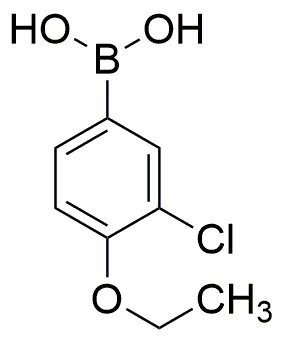3-Chloro-4-ethoxyphenylboronic acid is widely utilized in research focused on:
- Drug Development: This compound serves as a key intermediate in the synthesis of various pharmaceuticals, particularly in the development of anti-cancer agents. Its ability to form stable complexes with biomolecules enhances drug efficacy.
- Organic Synthesis: It is employed in cross-coupling reactions, such as Suzuki-Miyaura coupling, which is essential for creating complex organic molecules. This application is crucial in the production of agrochemicals and fine chemicals.
- Material Science: The compound is used in the fabrication of advanced materials, including polymers and nanomaterials, which are essential for electronics and renewable energy technologies.
- Bioconjugation: It plays a role in bioconjugation processes, allowing researchers to attach biomolecules to surfaces or other molecules, which is vital in developing biosensors and diagnostic tools.
- Research in Catalysis: This chemical is significant in catalysis research, where it aids in the development of new catalytic systems that can enhance reaction efficiency and selectivity in various chemical processes.
General Information
Properties
Safety and Regulations
Applications
3-Chloro-4-ethoxyphenylboronic acid is widely utilized in research focused on:
- Drug Development: This compound serves as a key intermediate in the synthesis of various pharmaceuticals, particularly in the development of anti-cancer agents. Its ability to form stable complexes with biomolecules enhances drug efficacy.
- Organic Synthesis: It is employed in cross-coupling reactions, such as Suzuki-Miyaura coupling, which is essential for creating complex organic molecules. This application is crucial in the production of agrochemicals and fine chemicals.
- Material Science: The compound is used in the fabrication of advanced materials, including polymers and nanomaterials, which are essential for electronics and renewable energy technologies.
- Bioconjugation: It plays a role in bioconjugation processes, allowing researchers to attach biomolecules to surfaces or other molecules, which is vital in developing biosensors and diagnostic tools.
- Research in Catalysis: This chemical is significant in catalysis research, where it aids in the development of new catalytic systems that can enhance reaction efficiency and selectivity in various chemical processes.
Documents
Safety Data Sheets (SDS)
The SDS provides comprehensive safety information on handling, storage, and disposal of the product.
Product Specification (PS)
The PS provides a comprehensive breakdown of the product’s properties, including chemical composition, physical state, purity, and storage requirements. It also details acceptable quality ranges and the product's intended applications.
Certificates of Analysis (COA)
Search for Certificates of Analysis (COA) by entering the products Lot Number. Lot and Batch Numbers can be found on a product’s label following the words ‘Lot’ or ‘Batch’.
*Catalog Number
*Lot Number
Certificates Of Origin (COO)
This COO confirms the country where the product was manufactured, and also details the materials and components used in it and whether it is derived from natural, synthetic, or other specific sources. This certificate may be required for customs, trade, and regulatory compliance.
*Catalog Number
*Lot Number
Safety Data Sheets (SDS)
The SDS provides comprehensive safety information on handling, storage, and disposal of the product.
DownloadProduct Specification (PS)
The PS provides a comprehensive breakdown of the product’s properties, including chemical composition, physical state, purity, and storage requirements. It also details acceptable quality ranges and the product's intended applications.
DownloadCertificates of Analysis (COA)
Search for Certificates of Analysis (COA) by entering the products Lot Number. Lot and Batch Numbers can be found on a product’s label following the words ‘Lot’ or ‘Batch’.
*Catalog Number
*Lot Number
Certificates Of Origin (COO)
This COO confirms the country where the product was manufactured, and also details the materials and components used in it and whether it is derived from natural, synthetic, or other specific sources. This certificate may be required for customs, trade, and regulatory compliance.


